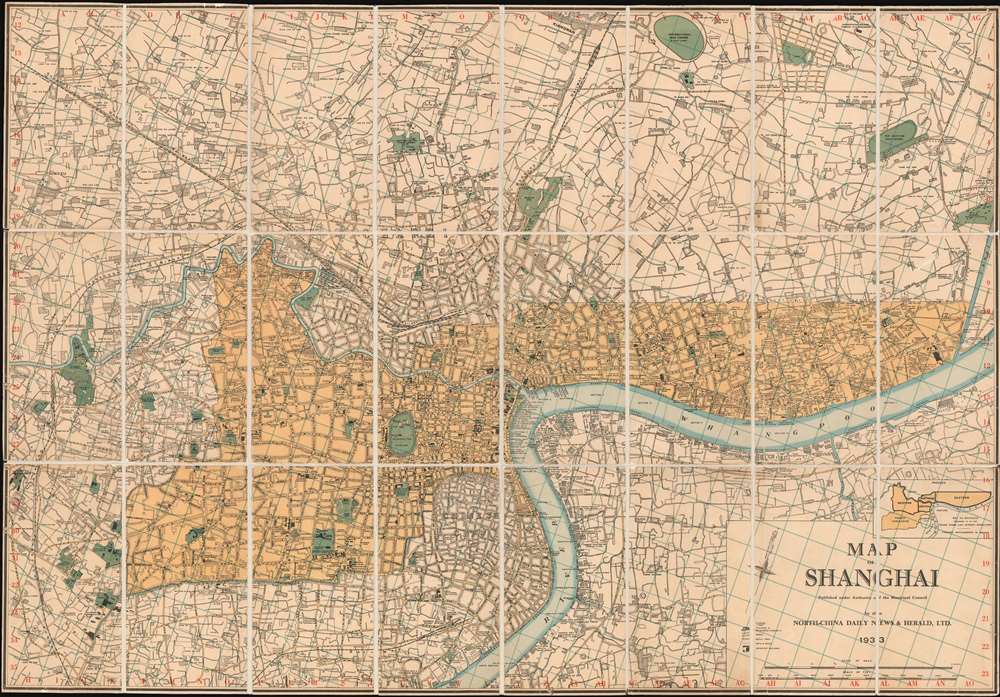1933 North-China Daily News Map of Shanghai, China
Shanghai-northchinadailynews-1933
Title
1933 (dated) 29.5 x 42.5 in (74.93 x 107.95 cm) 1 : 15840
Description
Shanghai International Settlement
The Shanghai International settlement was created in 1863 when the British and American Shanghai enclaves merged. These concessions had been granted to England and the United States as part of the Unequal Treaties that followed the Opium Wars. From about 1854 the settlements were governed by the Shanghai Municipal Council, a British dominated board of government officials and powerful merchants. The board issued restrictions limiting Chinese habitation on International Settlement territory and oversaw the construction of public services, including Trams, a sewage system, highways, and port buildings. The International settlement expanded several times in the late 19th and early 20th century. It became an enclave of peace and prosperity when the Japanese invaded Shanghai in 1937 but this abruptly came to an end with the Japanese bombing of Pearl Harbor and subsequent invasion of the International Settlement in 1941. After the war the International Settlement lands were returned to Chinese sovereignty.The Beginning of the End
The 1910s-20s were a golden age for Shanghai. While China was ruled by Chiang Kai-shek, Shanghai was dominated by several consolidated foreign trade Concessions. Under the strict administrative control of the Concessions, the city became a cosmopolitan haven in the midst of political unrest and a center for global trade and finance. The Concessions occupied what is today central Shanghai's most desirable land, hugging the Huangpu River and Wusong River (Suzhou Creek). These extraterritorial European, Japanese, and American enclaves had elegant housing, fine roads, streetcars, elegant shops, clubs, and more. It was a place of excess, art, and extravagance, where fortunes could be made by the enterprising - and lost by the foolish. Moreover, lacking the moral constrains that limited social life in Europe and America, Shanghai became nexus for the opium trade, sexual excess, gambling, and other vices.This ephemeral world come crashing down on January 28, 1932, when the Shanghai Incident or January 28 Incident (January 28 - March 3, 1932) pitted the Republic of China against the Empire of Japan. Responding to Chinese student protests against the Japanese occupation of Manchuria, the Japanese Navy bombarded Shanghai. Chiang Kai-shek sent the Chinese army in to defend the Shanghai students, threatening to escalate the conflict. The League of Nations, fearing all-out war, united to demand a ceasefire, which was signed. Nonetheless, most consider The January 28 incident to be the opening salvo of the Second Sino-Japanese War (1938 - 1945) which ultimately merged into World War II.
Publication History and Census
This map is loosely derived from the Municipal Council Map of Shanghai of 1933, but has slightly different coverage, being more inclusive to the north but less inclusive to the west. The Shanghai Daily News published multiple maps of Shanghai in their role as the official record of the British Consulate. This map is rare with the OCLC/WorldCat identifying only one copy, located at the University of Chicago.CartographerS
The North-China Daily News (August 3, 1850 - March 31, 1951) was a Shanghai-based English-language newspaper active from about 1850 until 1951. The newspaper was founded as the North-China Herald by the British auctioneer Henry Shearman (June 7, 1813 - March 22, 1856). They added a daily publication in 1864, the North-China Daily News. The Herald gained prominence as the official record of the British Supreme Court for China and Japan and the British Consulate. Following Shearman's death, the newspaper was run by a series of competent editors who maintained and increased its position of prominence, such that it became the most influential foreign-language newspaper in China. The newspaper was acquired by Henry E. Morriss in 1901 and in 1924 established a prominent new location, the North China Daily News Building, at Number 17, the Bund. In 1941, during World War II, the newspaper suspected publication. They Herald was never published again, but the Daily continued to be published until ordered to stop in March of 1951 by the Chinese Communist Party. Their offices at the North China Daily News Building were seized by the Shanghai Municipal Government of the People's Republic of China. More by this mapmaker...
Shanghai Municipal Council (July 11, 1854 - 1943) was an organization of businessmen leaders in Shanghai active from middle part of the 19th century to the early 20th century. The organization was formed on July 11, 1854 by a group of influential western businessmen who argued that Shanghai suffered under a lack of proper municipal governance. It laid down land regulations and began to assist in the construction of new roads, established refuse collection, and even initiated taxation. By the late-1860s Shanghai's official governing body had been practically transferred from the individual concessions to the Shanghai Municipal Council (工部局). The British Consul was the de jure authority in the Settlement, but he had no actual power unless the ratepayers (who voted for the council) agreed. Instead, he and the other consulates deferred to the Council, which was made of 9 figures, 5 from the British Settlement, 2 form the American Settlement, and 2 from the Japanese Settlement. No Chinese were permitted to serve on the council until 1928. By the 1880s the council acquired a virtual monopoly over city utilities, controlling gas-suppliers, electricity producers and water-companies. Later, in the early 20th century, they also took control of rickshaws, tramways, and regulated opium sales and prostitution. The council maintained its own police force, fire service, and military reserve, the Shanghai Volunteer Corps (萬國商團). The Municipal Council was disbanded in 1943, in World War II, when the Japanese closed all foreign concessions (except the French). Learn More...

